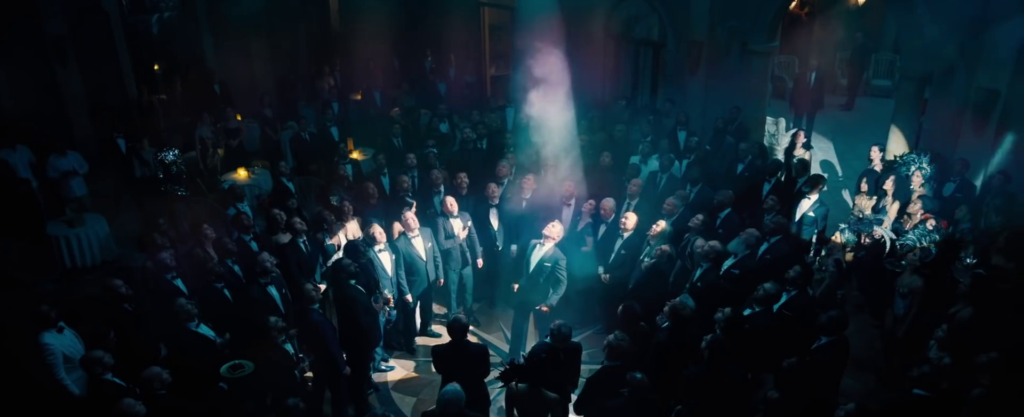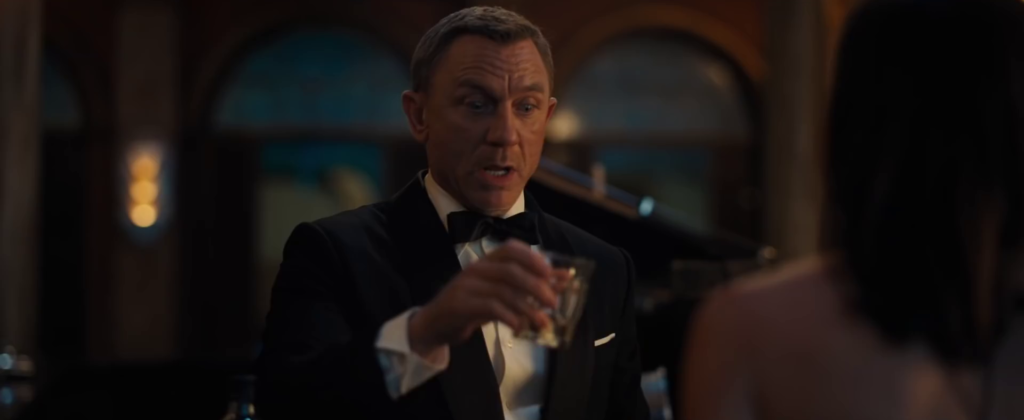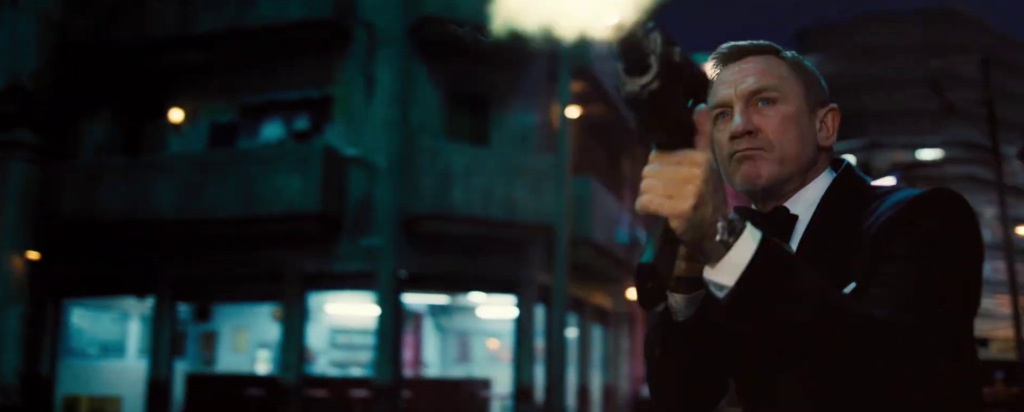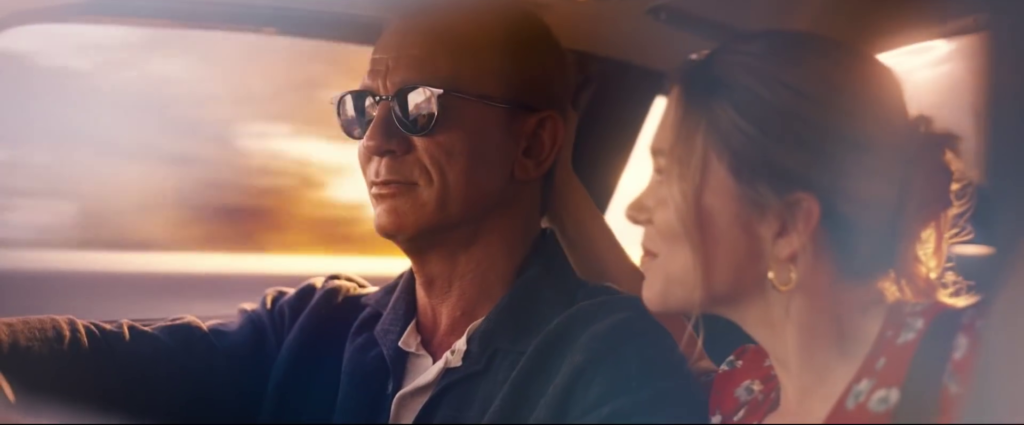
What does a James Bond fan look like? Think of a Star Wars fan, or a Star Trek fan, or a Harry Potter fan, and a certain image comes to mind, whether accurate or not. Can the same be said of the James Bond fan? The question is directly relevant to the new Bond film, No Time to Die (2021), which engages in the kind of fan service that has become de rigueur for contemporary franchise movies, i.e., callbacks and references to earlier works in the series. But who’s being serviced?
An informal survey I conducted prior to writing this article confirms that most associate Bond with their dad, or just dads in general. It was indeed my dad who took me to the video store when I was around 6 years old to rent my first Bond movie, Goldfinger (1964), and later that year I bonded with my first grade best friend’s dad about my love of The Man With The Golden Gun (1974). In contrast to the stereotypical image of the contemporary fanboy as an immature single man-child who lives in his mom’s basement, James Bond fandom is associated with a measure of social normality.
As someone who spent a significant portion of his life deeply engaged in the Bond fan community (mostly via the now-defunct IMDb message boards), I know more than most about the interests and desires of the typical Bond aficionado. What most separates Bond followers from other fandoms isn’t the level of knowledge or dedication, but rather the nature of their expectations—with Bond, there’s little difference between what the casual fan and the superfan expect from a new entry in the series. The casual Bond fan goes to the theater hoping to see cool action scenes, inventive gadgets, beautiful locales, memorable villains, and hot women. And the superfan, despite having a better shot at winning a round of James Bond trivia, wants to see those same things.
But with that said, Bond fans are no easy customers, and keeping them happy requires a potent combination of formulaic consistency and cultural mutability: The structure and basic narrative elements of the Bond film remain the same from decade to decade, but within that framework the filmmakers can find any number of saleable genres, tones, and aesthetics to borrow from. This has allowed the series to keep up with the times even after the zeitgeist passed it by. When blaxploitation was at its height, Bond was sent to Harlem to face adversary Yaphet Kotto in Live and Let Die (1973). After Enter the Dragon (1973), he was in Hong Kong and Bangkok doing kung fu in Golden Gun. After Star Wars (1977), he was sent to space for Moonraker (1979). And shortly after that, he went to Miami (engaging in his usual vices) to face a Scarface (1983)-esque drug lord in License to Kill (1989). In short, if you want to know what trends are dominating the popular cinema at any given time, look to 007.

What No Time to Die reflects is how, since Casino Royale (2006) helped jumpstart the gritty reboot renaissance, the franchise film has crystallized into a genre unto itself—separate from whatever specific genres a particular franchise might have initially been associated with. Something like Ant-Man (2015) may borrow standards of the heist film, but is so fully subservient to a larger house style that it’s nonetheless more accurately described as just a Marvel franchise movie anyway. This franchise genre also borrows significantly from the stylistic signatures of Christopher Nolan, whose Batman Begins (2005) was produced almost concurrently with Casino Royale and spoke to the same zeitgeist. Many of these films are characterized by muted colors, epic runtimes, attempting to root fantastical scenarios in the “real world,” dialogue littered with exposition and explicitly stated themes. Often the same themes, in fact—that these films tend to examine the roles of heroes and villains, and the thin line that separates one from the other, is unsurprising. It’s an easy way to complicate the typically uncomplicated morality usually associated with, and used as a knock on, more traditional genre pictures.
Another common theme between Craig-era James Bond films and other franchise movies feels less explicable to me. I am reminded of a video that recently went viral depicting Jamie Lee Curtis repeatedly describing Halloween (2018) as “a movie about trauma” while doing press for the film. With every iteration of the phrase, the word trauma begins to sound more and more ridiculous—truh-muh, traw-mah, trow-mah. But Laurie Strode isn’t the only franchise character whose trauma is repeatedly invoked, whether as a character motivator, character deepener, or simply a way to lend emotional gravitas. In No Time to Die, every major character is defined by some key damaging moment in their past that dictates their behavior in the present.
For James Bond, it’s two betrayals by the only two women he allowed himself to form emotional attachments with (thus, we can understand his guardedness and well-known callous womanizing ways). Lyutsifer Safin’s (Rami Malek) supervillainous plot is a response to seeing his entire family die before his eyes when he was a child. And a flashback that opens the film shows a young Madeleine Swann (Léa Seydoux), one of the women Bond believes betrayed him, bearing witness to her mother’s murder at the hands of a masked Safin. It’s easy and maybe even correct to dismiss the screenwriting 101 simplicity of these pieces of pop psychology. But what’s fascinating isn’t so much the use of trauma as a theme but rather the way that theme manifests itself in the tone and aesthetic of the aforementioned franchise film tradition. That contemporary cinema’s dominant popular mode has become so deeply infused with pain, loss, grief, and, yes, trauma—even if it’s traw-mah—feels significant in a way that’s difficult to fully evaluate.
The Bond movies have always been violent, but seldom did that violence register as anything more than a function of the action movie genre (Yaphet Kotto being given a pill that makes him expand and explode like a balloon isn’t exactly the stuff of nightmares). Maybe the movies are the wrong precedent to look at… in many ways, No Time to Die feels much more clearly indebted to James Bond video games than to the other films in the series (director Cary Joji Fukunaga is a well-known gamer, so much so that there were rumors he held up filming in order to spend more time with his Playstation). The first-person shooter format, which GoldenEye 007 (Nintendo 64, 1997) and subsequent Bond games revolutionized, is directly evoked by a complex long take in No Time to Die’s climax, which follows Bond from behind as he battles his way through various henchmen while attempting to reach a specific room in the villain’s complex lair. Callbacks to Goldfinger, On Her Majesty’s Secret Service (1969), and The Living Daylights (1987), not to mention the other Craig films, also read like something one would see in a Bond video game, where characters and objects from different films appear cheekily alongside each other in remixed scenarios.

Perhaps the most important aspect of No Time to Die that’s found in the video games but not in the other Bond films is the film’s shocking conclusion. This is your obligatory spoiler warning.
There’s no doubt that James Bond is dead by the end of No Time to Die. Dead dead. Nine missiles rain down on him as he bleeds out from a gunshot wound (he’s also been poisoned, but that doesn’t affect him). This is not supposed to happen in a James Bond film, despite the peril the MI6 agent often finds himself in. But it happens all the time in the James Bond video games—anytime you, the player, fail to beat a level, and thus effectively kill James Bond. Not to worry, though, since you can bring him back to life whenever you respawn, or buy the next game. And indeed the end credits of No Time to Die deliver the familiar promise: “James Bond Will Return.”
We have become accustomed to viewing our heroes as martyrs, whether or not these heroes actually die. Superman sacrifices himself for the greater good at the end of Batman v Superman: Dawn of Justice (2016), but not to worry, the Justice League discovers a way to resurrect him in the sequel. Leia and Luke Skywalker both seem done for by the end of The Last Jedi (2017), but reappear as “force spirits” in The Rise of Skywalker (2019). Fifty percent of the Avengers die in Infinity War (2018), except, surprise, not really. Even Bugs Bunny has a brush with mortality in Space Jam: A New Legacy (2021), ascending to the Warnerverse heavens after hitting a game-winning stepback three.
Birth, death, and rebirth are quickly cycled through in the franchise film, and then repeated endlessly. In the origin story, a character is born, an act of becoming. Soon after, this character is put in a situation where they are forced to give their life to save humanity, or something equivalently noble. And then they return, literally or figuratively, to save the world again. You may recognize this arc as the story of Jesus Christ.

The messiah-ification of the action hero feels especially odd in the case of James Bond, who’s always felt like the least noble and most devilish of the canonical franchise movie protagonists. Sure, he is ostensibly meant to be doing good—don’t bother looking into what the MI6 was actually doing throughout the 20th century—but his duty always seemed like something of an afterthought to him. The main attraction of his job was indulging in the luxuries available to him as an agent of the British government, and “keeping the British end up” through sexual conquest of the globe.
The old adage about James Bond is that men want to be him, and women want to be with him. But the Craig films have done everything possible to undermine that sentiment. Being James Bond used to mean travelling the world, wearing nice suits, driving sleek sports cars, and bedding beautiful women. There was never the sense that he was in any real danger; taking down supervillains almost seemed like a fun challenge for him. But to be James Bond in the 21st century is to take a beating, both physically and emotionally. Every person you love will betray you or perish, leaving you deeply emotionally stunted. And then you die.
So as much as the English-language franchise film is criticized for its sycophantic commitment to fan service, many don’t give the fan a particularly good deal. These films satisfy through callbacks and references to earlier media, ostensibly reminding audiences what made them fans in the first place. But in exchange they must watch the heroes they love suffer and die. And further, the ability to identify with, or even to aspire to be, the characters onscreen becomes completely severed. You are merely a witness to the pain of a deity, a savior who dies for you. You don’t have the power to save yourself; you can only await his “return.”
No Time to Die is now playing.
Etan Weisfogel is a film and media critic based in Brooklyn.

